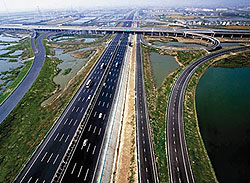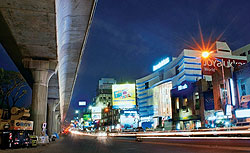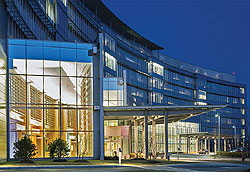|
SECTORS IN FOCUS
INFRASTRUCTURE FINANCING

A country’s infrastructure growth is directly linked to its economic prosperity. Cutting across sectors such as roads, powers, ports, airports and waterways, the government has estimated that India needs $1 trillion funding during the five-year period ending March 2017. Nearly half the investment is expected to come from the private sector. India now has special purpose vehicles (SPVs) and organizations in place that are able to lend funds, especially debt of longer-term maturity, directly to eligible projects to supplement loans from banks and financial institutions. They are able to provide innovative financing solutions to promote and develop world-class infrastructure in India. To accelerate the flow of off-shore funds, foreign investors who meet with KYC guidelines have been allowed to invest directly in Indian mutual funds. In addition, the ceiling for investment by FIIs into corporate bonds has been enhanced considerably from the existing $15 billion to $40 billion.
URBAN INFRASTRUCTURE

It is estimated that India’s population will grow to 1.7 billion by 2050 and that rapid urbanization will add nearly 900 million people to Indian cities. City capacity will need to grow nearly 400% in less than 50 years. There is tremendous pressure on civic infrastructure systems such as water supply, sewerage and drainage, solid waste management, etc. The aggregate investment envisaged during the 12th Five-Year Plan, from 2012–17, for urban water supply is Rs. 108,168 crore, for urban sewerage and sewage treatment at Rs. 50,780 crore and for urban transport an outlay of Rs. 1 lakh crore per year for 20 years.
TOURISM AND HOSPITALITY

Investment in tourism infrastructure is the thrust area for the Government of India, as well as the state governments. With over $17 billion in earnings, tourism has emerged as India’s fourth-largest forex earner. In terms of growth in international tourism receipts, India has clocked a CAGR of 12.9%, which is higher than 9.5% at the Asia-Pacific level and 6.1% globally.
The hotel and tourism sector witnessed a spurt in FDI in April 2013, attracting $2.32 billion after a surge in foreign hospitality players entering the space. This followed the sector being declared a high priority sector in March 2012. As per the FDI policy, 100% FDI under the automatic route is allowed in the sector into all construction and development projects, including construction of hotels and resorts, recreational facilities, and city and regional-level infrastructure. This includes opportunities in infrastructure and destination development, integrated development of tourist circuits, large revenue generation projects, capacity building for rural tourism and promotion of adventure tourism, subject to applicable laws/regulations, security and other conditional ties.
HEALTHCARE AND MEDICAL VALUE TRAVEL

The Indian healthcare industry was estimated at $65 billion in 2012 and it is expected to grow to $100 billion by 2015; the sector is expected to grow at a CAGR of 15% for the next decade. The public sector’s share in total healthcare expenditure stands at just around 20%. Significantly, private players have made large investments in setting up state-of-the art hospitals and diagnostics facilities and have a formidable presence in the metros such as New Delhi, Mumbai, Chennai, Bangalore and Hyderabad, and are increasingly penetrating tier-II and tier-III cities. Key drivers of this growth are a rising population, increasing disposable incomes, increasing lifestyle-related health issues, improving health insurance penetration, government initiatives and focus on public-private partnership (PPP) models. Most Indian metros have hospitals with world-class infrastructure, processes and outcomes. However, since 70% of the healthcare infrastructure is confined to the top 20 cities of India, innovations both in healthcare technology and delivery are required in order to make quality healthcare accessible to all.
Another key driver of this growth has been medical value travel. Substantially lower costs and long waiting periods in developed nations have been key drivers of this trend. A recent study has indicated that 850,000 medical tourists visited India in 2011 and the number is expected to touch 3,200,000 by 2015.
EDUCATION

The emergence of India as a knowledge-based, service-driven economy has brought human capital development in the country to the centre stage of socio-economic development planning. India is bestowed with a young population base, with over 50% of the population in the age-group of 18–30 years. It is estimated that by about 2025, India will have 25% of the world’s total workforce. With over 692 universities, 46,430 colleges and 25.9 million students, the Indian higher education sector boasts of having the largest higher education system in the world and being second-largest in terms of student enrolment.
The country provides an attractive market for global players as it is likely to grow to $115 billion in the next seven years. Expenditure on higher education is likely to go up from the current $10.3 billion to $30 billion by 2017–18. Both the formal / core education sector (including K–12 and higher education) as well as the informal / non-core sector (such as coaching institutions, pre-schools and vocational institutions) are witnessing accelerated growth. In terms of vocational training, the major prospective areas from an investment perspective are banking and financial services, hospitality, IT/ITeS, and beauty and wellness. The new niché sectors witnessing growth are finishing schools, child-skill enhancement and e-learning. India has emerged as a strong market for investments in this sector due to its favourable demographics and being a services-driven economy.
BACKGROUND
The Federation of Indian Chambers of Commerce and Industry (FICCI), the apex chamber of commerce in India, has long been a bellwether for Indian business and industry. In the late 90s, during the first decade of India’s economic reforms, and in keeping with its leadership role in India’s business and economic landscape, FICCI organised the Global Indian Entrepreneurs Conference in New Delhi to introduce the global investment community to the potential of the Indian economy in terms of talent, markets, opportunity and growth.
Subsequently in 2010, FICCI operationalised India’s official investment promotion agency (IPA), Invest India, as a means to provide operational support to business seeking to invest in India. Opened in partnership with the Department of Industrial Policy and Promotion (DIPP), Ministry of Commerce and Industry, Government of India and the state governments to bolster the inflow of foreign direct investment (FDI) into the country, Invest India is the government-nominated IPA for India and is the first point-of-reference for investors seeking guidance on doing business in India.
FICCI, through Invest India, is now pleased to announce the first edition of the Global Indian Business Conference (GIBC), with the intent of providing a platform to the global investment community to connect with stakeholders in India. A one-day programme, the investment interaction is designed to showcase investment opportunities across key sectors in India and to highlight Central government initiatives on improving the enabling environment for investors. Sessions will include sector-specific granulated discussions for a better understanding about policies, incentives, compliance norms, time lines and other practical requirements. In short, GIBC is about finding a way to do business better in India and is a well-timed opportunity to bring back investor confidence in India through dialogue between industry, government and other stakeholders.
ABOUT INVEST INDIA
Invest India, a not-for-profit organisation, has the mandate for attracting investments into the country in a structured, focused and comprehensive manner. It is the first point of reference for both domestic and foreign investors, and investment promotion and facilitation constitute the core mandate of the company.
Its services include providing quality input and support services — particularly to MSMEs and family-owned overseas enterprises — through granulated, sector-specific and state-specific information, assistance with location identification, expedition of regulatory approvals, facilitation of meetings with relevant government officials, organization of investment road shows and roundtables, and aftercare services that include initiating remedial action on problems faced by investors by involving the government department concerned.
ABOUT FICCI
Established in 1927, FICCI is the largest and oldest apex business organisation in India. Its history is closely interwoven with India’s struggle for independence, its industrialization, and its emergence as one of the most rapidly growing global economies. FICCI has contributed to this historical process by encouraging debate, articulating the private sector’s views and influencing policy. A non-government, not-for-profit organisation, FICCI is the voice of India’s business and industry. FICCI draws its membership from the corporate sector, both private and public, including SMEs and MNCs; FICCI enjoys an indirect membership of over 250,000 companies from over 300 regional chambers of commerce and industry associations.
ABOUT INDIA EMPIRE GROUP
Established in 2004, the India Empire Group brings in specialization and expertise in engaging with the global Indian. Through its flagship publication, India Empire, the group has managed to become a voice for overseas Indians. The group also produces publications of Indian industry bodies, embassies and high commissions, and overseas Indian institutions. It remains the very first publication brought out from India with its major focus on global Indians, starting with its inaugural issue in October 2004.
TO KNOW MORE, CONTACT:
Ms. Bhavna Seth Ranjan
bhavna.ranjan@ficci.com, +91.9810400069
Mr. Sayantan Chakravarty
sayantanc@gmail.com, +91.9899117477
REGISTRATION
For registration, please log on to www.gibc2014.com
|